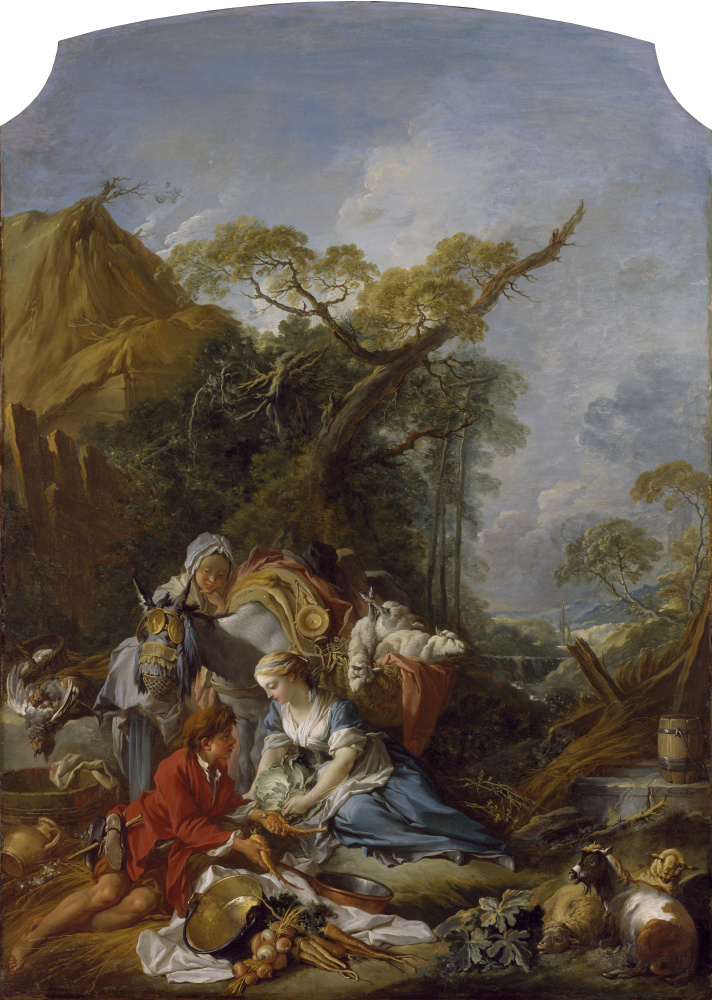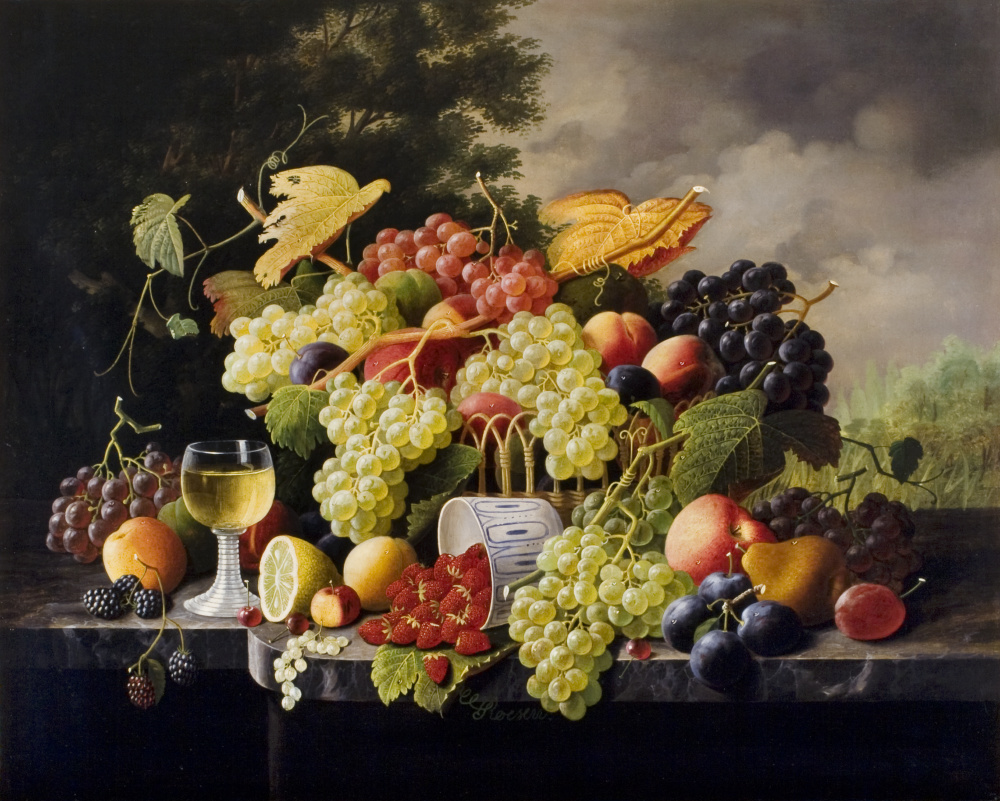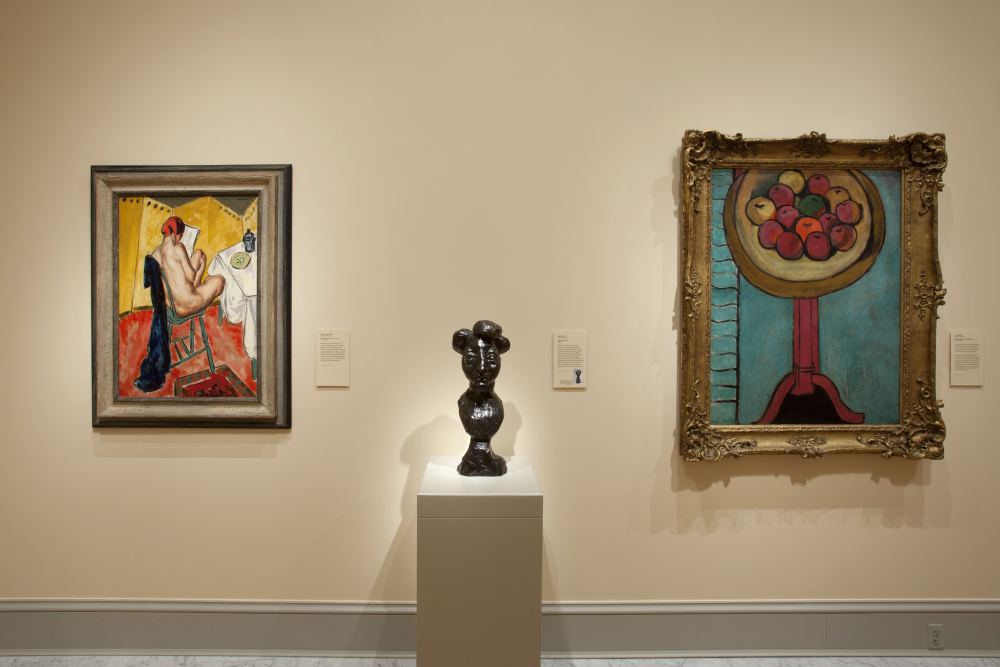- Open today, 10 am to 5 pm.
- Parking & Directions
- Free Admission
The Art of the Feast
–Emily Shield, Public Programs Coordinator
As we embark on occasions for gathering and merry-making this holiday season, food is sure to play a central role. Don’t just indulge at your table. Visit the Chrysler Museum and enjoy a feast for the eyes in our galleries with artworks that demonstrate the enduring presence of food and drink in art. Here are a few highlights to whet your appetite.
Francois Boucher’s Pastorale: The Vegetable Vendor

François Boucher (French, 1703–1770), Pastorale: The Vegetable Vendor, ca. 1735, Oil on canvas, Gift of Walter P. Chrysler, Jr., 71.504
Francois Boucher’s Pastorale: The Vegetable Vendor (ca. 1735) has all the makings of a delectable feast—vegetables, lamb, and poultry. With the pots in the foreground, soup may be the first thing to come to mind. However, there’s a cheekier tale being told. This large painting depicts a young kitchen maid bartering for produce from a youthful farm boy as another maid and donkey look on, but this is no simple transaction. Instead, Boucher gives us a scene of young love. The young man offers his firm carrots to the maid, who seems to be reciprocating with a bashful offer of a leafy cabbage. Scenes like this one were created for the amusement of the eighteenth-century French elite. Those who lived in luxury held romantic fantasies of the lives of the peasants and lower classes, and these coded messages of love and sensuality added another layer to the fantasy.
Despite the voyeurism and idyllic imagination inherent in this work, the painting also serves as a reminder that so many of our associations with food and celebration are connected to our loved ones. From generations-old family traditions and making new memories with our chosen families and friends to remembering those no longer with us or far away, holidays bring us together around food.
After enjoying Boucher’s work at the Museum, continue the experience at home with our Date Night-In Kit. Enjoy a recipe, playlist, hands-on activity, and movie suggestions inspired by the painting.
Severin Roesen’s Still Life with Fruit

Severin Roesen (American (born Germany), 1816–1872), Still Life with Fruit, ca. 1859, Oil on canvas, Gift of Walter P. Chrysler, Jr., 71.698
After Boucher’s hearty feast, a palette cleanser of luscious fruit and wine seems an excellent treat. Severin Roesen’s Still Life with Fruit (ca. 1859) serves an overflowing basket of plump, juicy produce. Roesen exercises impeccable skill as he captures the various textures of the smooth marble sill, the seeded strawberries, grapes full to bursting with juice, and the cool smooth glass of white wine. The brightly lit scene stands out against a more muted background that alludes to the origin of the array in front of us; the fruits and wine come from the local land of this scene.
Roesen presents incredible details, including the delicate strawberry vine in the bottom center that becomes the artist’s signature, the tiny drops of water and dew on the fruits, and the translucency of the wine. He also includes several leaves that are changing colors and beginning to decay—reminders that a time of harvest also suggests the impending arrival of a more barren winter. Still lifes often contain these signifiers; despite the richness we may see, nothing lasts forever. Indicators found in other paintings include burnt-out candles, skulls, and timepieces to acknowledge the effects of the passage of time.
Still lifes have been popular in art for centuries, and American artists in the nineteenth century often chose to work in European traditions to prove themselves in a field still dominated by the major European cities. Roesen was an immigrant from Germany, which is an important reminder that many of our holiday traditions were brought to the United States from other countries by generations of immigrant families. Still life paintings were popular among American audiences, especially among the elite, because they demonstrate plenty and bounty, characteristics associated with the ideals of American life. For us, paintings such as these are also a reminder that the American Dream is not a reality for everyone living in this country. The holiday season can be especially challenging. Thankfulness, generosity, and empathy play vital roles in acknowledging the needs of others.
Henri Matisse’s Bowl of Apples on a Table
The arrival of the twentieth century brought many changes to art and new riffs on familiar refrains. A prime example is Henri Matisse’s Bowl of Apples on a Table (1916) which, as the title suggests, is a simple still life of a colorful bowl of fruit on a table. However, tension and unease permeate the painting. With Matisse’s play on perspective, we sense that the apples sit in a precarious position, on the verge of toppling. We can imagine the slow-motion fall, the clang of the bowl on the floor, and the chaos of apples rolling everywhere. There is a discomfort in this painting that may feel familiar to many. While the holiday season may be a time for gathering and camaraderie, not everyone has the good fortune to feel at ease. Although unique, several elements of Matisse’s work are similar to Roesen’s still life, including the abundance of fruit, the saturated colors, and sparse setting surrounding the primary subject matter.
A Glass Take on Matisse
Add a Matisse-inspired work to your décor with Not So Still Life, available at the Museum Shop. The hand-blown and sculpted glass work by artists Kim McKinnis and John R.G. Roth was created especially for the Chrysler Museum. Production is limited to 100 sculptures.
This holiday season, we hope the Chrysler Museum of Art will be a source of joy and a place to gather with family and friends to discover new things and perhaps meet new people too. Tour our galleries, enjoy the collection and special exhibitions on view, and indulge in a feast for the eyes and mind.
The Museum and Glass Studio will be closed on Thanksgiving Day and re-open on Friday, November 26.



